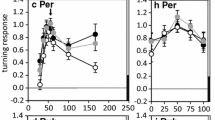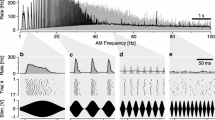Summary
We have investigated the effects of alterations of several temporal parameters of auditory stimuli, as well as of stimulus intensity changes, on the attractiveness of these stimuli to femaleTeleogryllus oceanicus, as measured by monitoring sound-elicited flight steering responses. AlthoughT. oceanicus has a rhythmically complex calling song, females are attracted by a simpler model consisting of regularly repeating sound pulses. We have found that the two major temporal features of this model, sound pulse duration and pulse repetition rate, are both important for eliciting phonotactic steering responses.
Stimuli with altered temporal features had intensity thresholds indistinguishable from the control stimulus (Fig. 3). The majority of crickets, however, ceased to respond to the altered stimuli when the stimulus intensity was sufficiently increased (Figs. 4–7). In some cases, intensity increases resulted in a reversal of the steering response from positive to negative (Fig. 10). Effects of altered temporal parameters were also apparent at lower stimulus intensities, where the amplitudes of steering responses to stimuli with altered parameters were smaller than those in response to the control stimulus (Figs. 8, 9).
We considered the possibility that the cessation of responsiveness to stimuli with altered temporal features was due to a temporal pattern-specific diminution of binaural cues for sound localization at high intensities. Experiments performed with unilaterally deafened crickets (Fig. 11) led us to conclude that this was not the case, and that our findings instead reflect the properties of the song recognition mechanism.
Similar content being viewed by others
Abbreviations
- UIL :
-
upper intensity limit
- RAF :
-
ratio of abdominal flexion
References
Alexander RD (1975) Natural selection and specialised chorusing behaviour in acoustical insects. In: Pimental D (ed) Insects, science and society. Academic Press, New York, pp 35–77
Bentley DR, Hoy RR (1972) Genetic control of the neuronal network generating cricket (Teleogryllus, Gryllus) song patterns. Anim Behav 20:478–492
Cade WH (1981) Field cricket spacing, and the phonotaxis of crickets and parasitoid flies to clumped and isolated cricket songs. Z Tierpsychol 55:365–375
Doherty JA (1985) Trade-off phenomena in calling song recognition and phonotaxis in the cricket,Gryllus bimaculatus (Orthoptera, Gryllidae). J Comp Physiol A 156:787–801
Doolan JM (1982) Acoustic communication in the cicada,Cystosoma saundersii. Ph D thesis, University of Melbourne
Eilts-Grimm K, Wiese K (1984) An electrical analogue model for frequency dependent lateral inhibition referring to the Omega neurons in the auditory pathway of the cricket. Biol Cybern 51:45–52
Eisner N, Popov AV (1978) Neuroethology of acoustic communication. Adv Insect Physiol 13:229–355
Helversen D von (1972) Gesang des Männchens und Lautschema des Weibchens bei der FeldheuschreckeChorthippus biguttulus (Orthoptera, Acrididae). J Comp Physiol 81: 381–422
Hill KG, Loftus-Hills JJ, Gartside DF (1972) Pre-mating isolation between the Australian field cricketsTelegryllus commodus andT. oceanicus (Orthoptera, Gryllidae). Aust J Zool 20:153–163
Hoy RR (1978) Acoustical communication in crickets:a model system for the study of feature detection. Fed Proc 37: 2316–2323
Koch UT (1980) Analysis of cricket stridulation using miniature angle detectors. J Comp Physiol 136:247–256
Leroy Y (1964) Transmission du paramètre fréquence dans les signaux acoustiques des hybrides F1 et P×F1 de deux grillons:Teleogryllus commodus Walker etT. oceanicus Le Guillou (Orthoptères, Ensifères) CR Acad Sci [D] (Paris) 259:892–895
Lloyd JE (1973) Model for the mating protocol of synchronously flashing fireflies. Nature 145:268–270
Moiseff A, Hoy RR (1983) Sensitivity to ultrasound in an identified auditory interneuron in the cricket: a possible link to phonotactic behavior. J Comp Physiol 152:155–167
Moiseff A, Pollack GS, Hoy RR (1978) Steering responses of flying crickets to sound and ultrasound: mate attraction and predator avoidance. Proc Natl Acad Sci USA 75:4052–4056
Nolen TG, Hoy RR (1984) Initiation of behavior by single neurons: the role of behavioral context. Science 226: 992–994
O'Neill WE, Suga N (1979) Target range-sensitive neurons in the auditory cortex of the mustache bat. Science 203:69–73
Pollack GS (1982) Sexual differences in cricket calling song recognition. J Comp Physiol 146:217–221
Pollack GS, Hoy RR (1979) Temporal pattern as a cue for species-specific calling song recognition in crickets. Science 204:429–432
Pollack GS, Hoy RR (1981) Phonotaxis to individual rhythmic components of a complex cricket calling song. J Comp Physiol 144:367–373
Pollack GS, Huber F, Weber T (1984) Frequency and temporal pattern-dependent phonotaxis of crickets (Teleogryllus oceanicus) during tethered flight and compensated walking. J Comp Physiol A 154:13–26
Pollack GS, Plourde N (1982) Directionality of acoustic orientation in flying crickets. J Comp Physiol 146:207–215
Popov AV, Shuvalov VF (1977) Phonotactic behaviour of crickets. J Comp Physiol 119:111–126
Rheinlaender J (1975) Transmission of acoustic information at three neuronal levels in the auditory system ofDecticus verrucivorus (Tettigoniidae, Orthoptera). J Comp Physiol 97:1–53
Richards DO, Wiley RH (1980) Reverberations and amplitude fluctuations in the propagation of sound in a forest:implications for animal communication. Am Nat 115:381–399
Sandeman DC (1968) A sensitive position measuring device for biological systems. Comp Biochem Physiol 24:635–638
Schildberger K (1984) Temporal selectivity of identified auditory neurons in the cricket brain. J Comp Physiol A 155: 171–185
Shuvalov VF, Popov AV (1973) Significance of some of the parameters of the calling songs of male cricketsGryllus bimaculatus for phonotaxis of females. J Evol Biokh Fiziol 9:177–182
Sokal R, Rohlf JF (1969) Biometry. Freeman, San Francisco
Stout JF, Dehaan CH, McGhee RW (1983) Attractiveness of the maleAcheta domesticus calling song to females. I. Dependence on each of the calling song features. J Comp Physiol 153:509–521
Suga N (1965) Functional properties of auditory neurons in the cortex of echolocating bats. J Physiol (Lond) 181:671–700
Suga N (1977) Amplitude spectrum representation in the Doppler-shifted-CF processing area of the auditory cortex of the mustache bat. Science 196:64–67
Thorson J, Weber T, Huber F (1982) Auditory behaviour of the cricket. II. Simplicity of calling-song recognition inGryllus, and anomalous phonotaxis at abnormal carrier frequencies. J Comp Physiol 146:361–378
Tomioka K, Yamaguchi T (1980) Steering responses of adult and nymphal crickets to light, with special reference to the head rolling movement. J Insect Physiol 26:47–57
Tsuch G (1976) Der Einfluss synthetischer Gesänge auf die Weibchen vonGryllus bimaculatus DeGeer. Zool JB Physiol 80:383–388
Ulagaraj M, Walker TJ (1975) Response of flying mole crickets to three parameters of synthetic songs broadcast outdoors. Nature 253:530–532
Walker TJ (1957) Specificity in the response of female tree crickets (Orthoptera, Gryllidae, Oecanthinae) to calling songs of the males. Ann Entomol Soc Am 50:626–636
Weber T, Thorson J, Huber F (1981) Auditory behaviour of the cricket. I. Dynamics of compensated walking and discrimination paradigms on the Kramer treadmill. J Comp Physiol 141:215–232
Wendler G, Dambach M, Schmitz B, Scharstein H (1980) Analysis of the acoustic orientation behaviour in crickets. Naturwissenschaften 67:99–100
Wiley RH, Richards DG (1978) Physical constraints on acoustic communication in the atmosphere implications for the evolution of animal vocalisations. Behav Ecol Sociobiol 3:69–94
Winer BJ (1962) Statistical principles in experimental design. McGraw-Hill, New York
Zaretsky MD (1972) Specificity of the calling song and short term changes in the phonotactic response by female crickets,Scapsipedus marginatus (Gryllidae). J Comp Physiol 79:153–172
Author information
Authors and Affiliations
Rights and permissions
About this article
Cite this article
Doolan, J.M., Pollack, G.S. Phonotactic specificity of the cricketTeleogryllus oceanicus: intensity-dependent selectivity for temporal parameters of the stimulus. J. Comp. Physiol. 157, 223–233 (1985). https://doi.org/10.1007/BF01350029
Accepted:
Issue Date:
DOI: https://doi.org/10.1007/BF01350029




